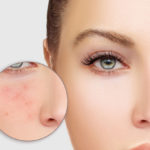This week’s post goes out to ladies who fight facial hair. And you know who you are.
Have you ever looked in the mirror one day only to see a dark hair or two you could’ve sworn weren’t there before? Fear not, you aren’t turning into the Bearded Lady or the Wolfman overnight.
Most women have some sort of facial hair, but these fine vellus hairs (or “peach fuzz” as it’s more commonly called) are rarely worth fussing over. However, occasionally a smaller, darker hair will pop up in your reflection and you’re wondering what is up with that?!
So the real question remains: are these dark hairs hormonal, do they come from your genes, or is there another reason? And perhaps more importantly, how do you get rid of them?
What are the Causes?
Your genetic makeup has you predisposed to where and how these hairs will appear on the face, while hormones handle when they spring up. Women whose heritage comes from a predominantly Indian/South Asian or Mediterranean background are more likely to have unwanted facial hair than women with European or Native American genetics. Whether or not these darker facial hairs run in your family also plays a role in whether or not you will get them, too.
Luckily for many, this is the smaller of the factors behind the hair growth. More likely than not, this issue is caused by something within your hormones. The most common cause of unwanted facial hairs is a hormonal imbalance, whether it’s because of pregnancy, menopause, Polycystic Ovarian Syndrome (PCOS), or a number of other changes that wreak havoc on the female body. This imbalance is caused by an increase in androgens or male hormones like testosterone, which all women naturally produce. The problem begins when the balance between the female and male hormones is tipped towards the latter, causing the body to produce darker hairs around the face.
A third but less common factor is medication causing the unwanted hairs. Medications like testosterone, some steroids, minoxidil (for high blood pressure,) and cyclosporine are known to have unwanted hair growth as a side effect.
How to Get Rid of Unwanted Facial Hair.
So now- whether it’s genetic or hormonal, what do you do about it? Luckily, there are plenty of options for getting rid of these pesky hairs.
- Tweezing or waxing – Quick and inexpensive but can be painful. Plus, the hair will continue to grow back.
- Shaving – Like tweezing it’s cheap and fast, but it will grow back the fastest.
- Depilatory creams – More expensive and the hair still returns.
- Medicated creams – Can cause rashes or skin irritation.
- Electrolysis – Uses an electric current to destroy the root of the hair. This will take care of hair growth, but can also cause scars.
- Laser hair removal – Concentrated light beams permanently damage the hair follicle so hair growth doesn’t come back. This is a great solution for women who desire a permanent solution with no scarring
All of these options can be discussed with your dermatologist to find the best fit for you. If you think your excessive hair growth may be caused by a hormonal imbalance, we recommend you consult with your physician.
If you’d like to discuss your excessive facial hair, we’re here to help. Click here to schedule an appointment with Dermatology Associates.
Dermatology Associates offers a full spectrum of leading edge medical, surgical, and cosmetic dermatology services from offices in Savannah and Vidalia.


